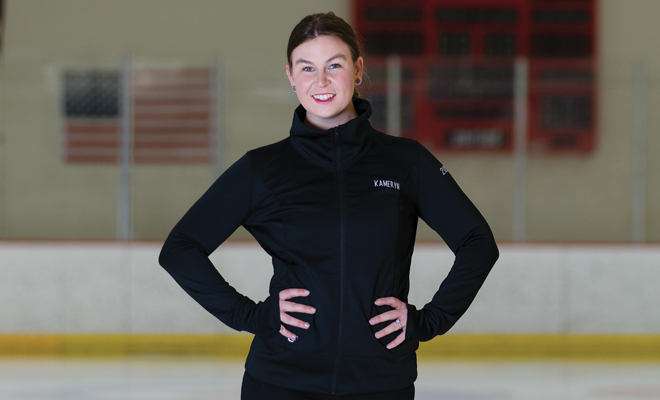 Amber J Deery
Amber J Deery
Kameryn Furman: “Synchronized ice skaters are elite athletes!”
It is a team sport that demands absolute individual power and accuracy that combine into precise lines and figures. Synchronized ice skating requires 38 blades gliding atop a frozen stage in perfect harmony. This sport holds a life-long passion for Kameryn Furman, Raymore, Missouri, who is now coaching the Kansas City Illusion; she guided the team to its first adult national competition in the USFS Synchronized Championship Events, March 2 through 6, 2022, in Colorado Springs, Colorado.
“I describe synchronized ice skating as a marching band on ice, between 12 and 20 athletes creating different formations and shapes while doing steps in unison to music,” explained Kameryn. “The scoring is at different levels for each of the shapes you make. You’re trying to get them ‘called,’ which means the technical panel says that, yes, they did all of the criteria and got the level that they’re going for in that element. Then there’s a judging panel that grades how good it was, not how hard it was, but how good it was. It’s the combination of those that give your overall score. There are five main element shapes: circle, wheel, straight line, block or multiple lines of people and intersection. To transition to those shapes, you might make another shape to get to those main five.”
History of the Sport
According to U.S. Figure Skating, the national governing body for the sport of figure skating in the United States, synchronized skating offers athletes the chance to compete with a team and learn the value of teamwork and camaraderie. Dr. Richard Porter established the sport in 1956, although it was called “precision skating” for the intricate moves skaters perform on the ice together. U.S. Figure Skating held the first U.S. Synchronized Skating Championships in 1984 and the first World Synchronized Skating Championships in 2000. Today, nearly 600 teams are registered synchronized teams in the United States. Teams of 8 to 20 skaters perform impressive formations and step sequences together. Competitions use the same judging system as singles, pairs and ice dance. All teams perform a free skate with required elements, and junior- and senior-level teams also perform a short program.
Kameryn began her love of ice skating as a toddler when she followed her older brother, who was playing hockey in St. Louis, onto the rink. “When you’re at the rink all the time with a sibling, you wind up on the ice. My parents put me on the ice and I loved skating with a team. I started when I was three and skated with the synchronized skating team in St. Louis called the St. Louis Synergy and stayed 16 seasons. I also coached a junior-level team, Team USA, representing the United States at international competitions. I got to coach them for two years and then I moved to Kansas City.”
She took a job as a mechanical engineer with Burns and McDonnell, and with the encouragement of her husband, Nick, she continued skating. A few years later, she took on the role of coach for the adult team in the Kansas City Illusion synchronized ice skating group. Kansas City Illusion is made up of seven teams, offering opportunities for three- to five-year-olds up to the oldest skaters in their 60s. All teams compete in USFS Synchronized Championship Events and travel around the Midwest to compete. The adult team that Kameryn coaches qualified for nationals this year for the first time, boasting a ranking of the top 13 adult teams in the nation.
“It’s been our goal for six years to make the national synchronized skating nationals. We’ve had three skaters who have been to nationals, but this has been a long-time dream for many on our team,” shared Kameryn. “They’re really excited to hit their goal and to experience it.” Kameryn adds she has been to nationals five times as a team member and five times as a coach.
Synchronized skating teams such as the Kansas City Illusion and all other levels can receive a national ranking against other synchronized skating athletes or teams from across the country at the National Synchronized Skating Series. Competitive levels are juvenile, intermediate, novice, junior, senior, collegiate, adult and masters. Kameryn has coached the adult Kansas City Illusion team through several sectional championships to qualify for the U.S. Synchronized Skating Championships.
“What keeps me going is knowing that all of these athletes, whether they’re 3 or 60, are learning to set goals and reach them. What is particularly impressive for this team is that they set a goal and worked toward it for six years,” noted Kameryn. “That’s what keeps me going because they are working as hard as they can to achieve this goal. Even through the pandemic, they stayed with it.”
Establishing Objectives; Making Them
Engineers are known for setting goals, measurements of success and strategies to achieve those objectives. Kameryn does this every day in her role at Burns and McDonnell. But she has also successfully transitioned that skill set to the ice and has established a two-pronged effort to grow the sport that she loves on a local and national basis with far-reaching competitive targets.
“My goal was to be on or coach Team USA in some way. Being able to do that in college as a coach was incredible. Now my goal is to expand synchronized skating where it’s not big. Most of the leaders are in major hubs such as Chicago, New York or Boston. In the Midwest, it’s not as big,” she commented. “So being able to expand this program and find skaters in the area that want to start at age three and go through the program and graduate from it is huge.”
Not only does she have big dreams for synchronized ice skating in the Kansas City metro, but she also has lofty dreams for the sport on an international level. Kameryn is on the ground floor of guiding synchronized ice skating to become an Olympic sport. “We’ve been trying to get the sport into the Olympics since 1986. We’re still on the Olympic ballot and we’re hopeful in 2026 to be an Olympic sport,” she remarked. “All clubs of any size are helping to promote the sport to be an Olympic sport.”
As for her personal goals for the future, Kameryn plans to keep working with these teams to see the club grow to be a top contender in multiple divisions. She wants the team qualifying for nationals more years than they do not. Right now, Kansas City Illusion has 70 athletes and her goal is to see that number over 100 because it is a tipping point for clubs to become highly competitive. She looks forward to many more years of coaching and continuing to support this team as it attains even more lofty goals.
“Anybody can do this sport. We have levels for adult, brand-new skaters through those experienced who have skated or coached Team USA in the Kansas City area. We have levels for everybody,” she advised. “It’s 19 skaters that are working women. One is retired, but everyone else works full time. We’re nurses, digital marketers, a power tool salesperson, engineers and more. We have this whole breadth of working women who also have a passion for skating that brings these people together. We’re also the first team from Kansas City to qualify for nationals.”
Anyone Can Glide on the Ice
Kameryn describes her team as a cross-section of American women, although she’s quick to point out that synchronized ice skaters are elite athletes, making up just .003 percent of the population. When you examine the numbers even further, the makeup of her team is varied, from a 20-year-old Mizzou student to women in their 50s. But her message remains constant: synchronized iced skating is one sport that can be welcoming to all who want to try.
“To begin, you have to find people, at least 12 willing to skate on a team. After that, it’s hours of practice. We meet weekly and then skaters practice individually as well. Going to competitions, we learn from our opponents and that helps fix our issues,” she said. “Over the last four years, we’ve missed going to nationals by just one placement. But we learned what was preventing us from qualifying and we fixed it. We did not grow up skating together. We came from different teams and different walks of life. We had to figure out what our skating style is and what we look like as a team.”
When we visualize ice skaters in our minds, we probably see figures gliding effortlessly and gracefully across a frozen stadium. Yet beneath that incredible beauty, hours of intense practice, observation and learning go into making skating appear so fluent. Kameryn describes it as a penetrating enthusiasm toward a goal and a compelling desire to seemingly float on the ice.
“Skating is a passion. For anybody who starts it and falls in love with it, it becomes a life-long sport. It fills my joy jar to give some of that joy to other skaters. It’s my passion and escape as well,” Kameryn said. “We tell our skaters that they should leave their real-world problems at the door and just skate. You’re out there without any connection to the world and you’re just skating.”









